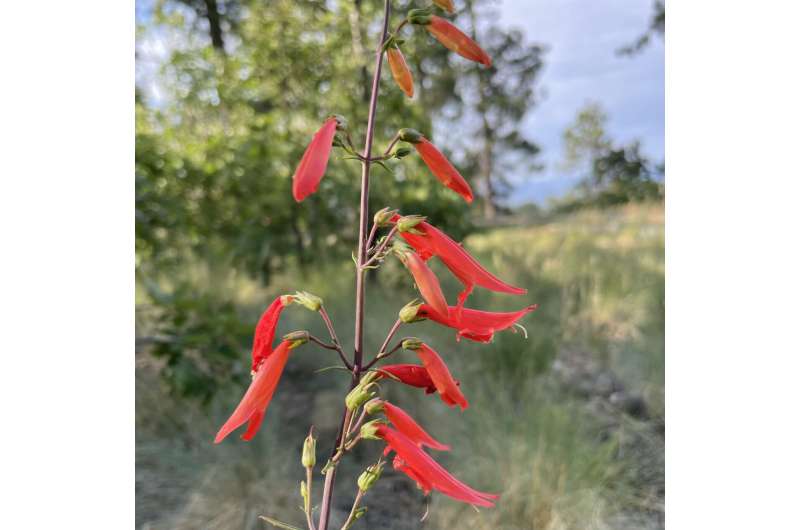This article has been reviewed according to Science X's editorial process and policies. Editors have highlighted the following attributes while ensuring the content's credibility:
fact-checked
peer-reviewed publication
trusted source
proofread
A few essential genetic differences tailor flowers to bee or hummingbird pollinators

Large differences in flower characteristics between wildflowers with different pollinators are achieved by a few key genetic differences, according to a study by Carolyn Wessinger at the University of South Carolina, US, and colleagues, published in the open access journal PLOS Biology.
Plants that rely on animal pollinators, such as insects or birds, have evolved distinctive suites of flower characteristics—known as "pollination syndromes"—that are tailored to the pollinator. For example, most plants in the Penstemon genus have wide, blue flowers that provide a landing pad for bees, but some species have evolved narrow, red, tube-like flowers that are adapted for pollination by hummingbirds.
To understand how these pollination syndromes are maintained at the genetic level, researchers sequenced the DNA of 229 plants from three related Penstemon species: two adapted for pollination by bees (P. neomexicanus and P. virgatus), and one that has adapted to hummingbird pollination (P. barbatus).
They found surprisingly few genetic differences that distinguish P. barbatus from its bee-pollinated relatives, despite large differences in flower characteristics. Overall, plants from the same region were more genetically similar than geographically more distant individuals, regardless of species, suggesting that there is genetic mixing between bee- and hummingbird-adapted wildflowers. However, they identified 21 sites that consistently differed between species with different pollinators.
These sites are distributed across the genome, making it more likely that the complementary suite of flower traits might be broken apart by recombination (the shuffling of maternal and paternal genes that occurs when gametes are made), creating less successful hybrids. Three of the genetic differences are close to genomic locations involved in flower color, width and nectar volume, traits that are distinctive to the different pollination syndromes.
The authors say that rare hybridization events between neighboring bee- and hummingbird-pollinated Penstemon species, combined with strong selection to maintain suites of flower characteristics adapted to each pollinator, could explain the results.
Dr. Wessinger said, "Although bee- vs. hummingbird-pollinated species are easily distinguished in the field, based on unmistakable differences in flowers and the overall stature of the plant, a surprisingly small number of genetic regions distinguish these different species at the genetic level."
More information: A few essential genetic loci distinguish Penstemon species with flowers adapted to pollination by bees or hummingbirds, PLoS Biology (2023). DOI: 10.1371/journal.pbio.3002294
Journal information: PLoS Biology
Provided by Public Library of Science


















